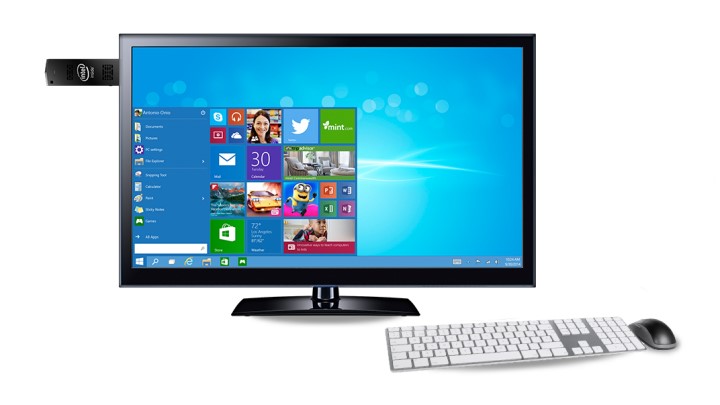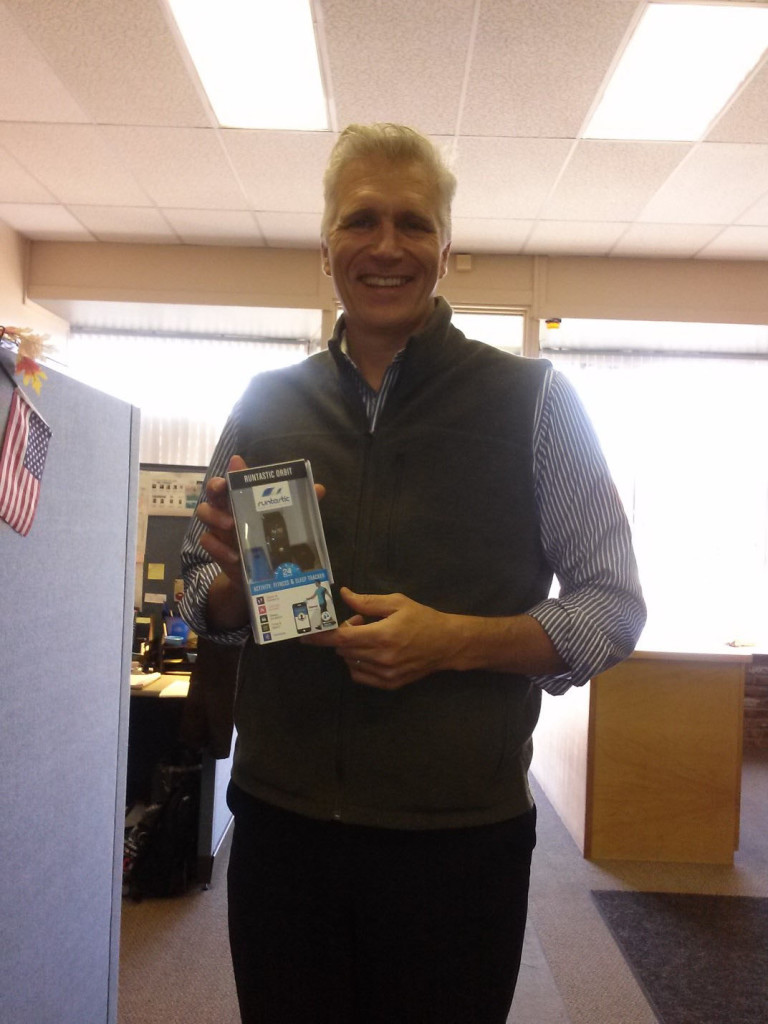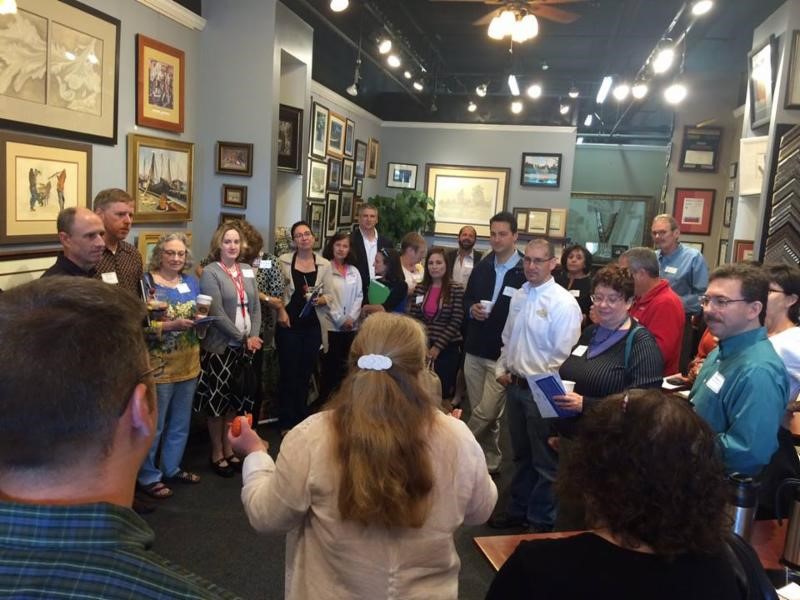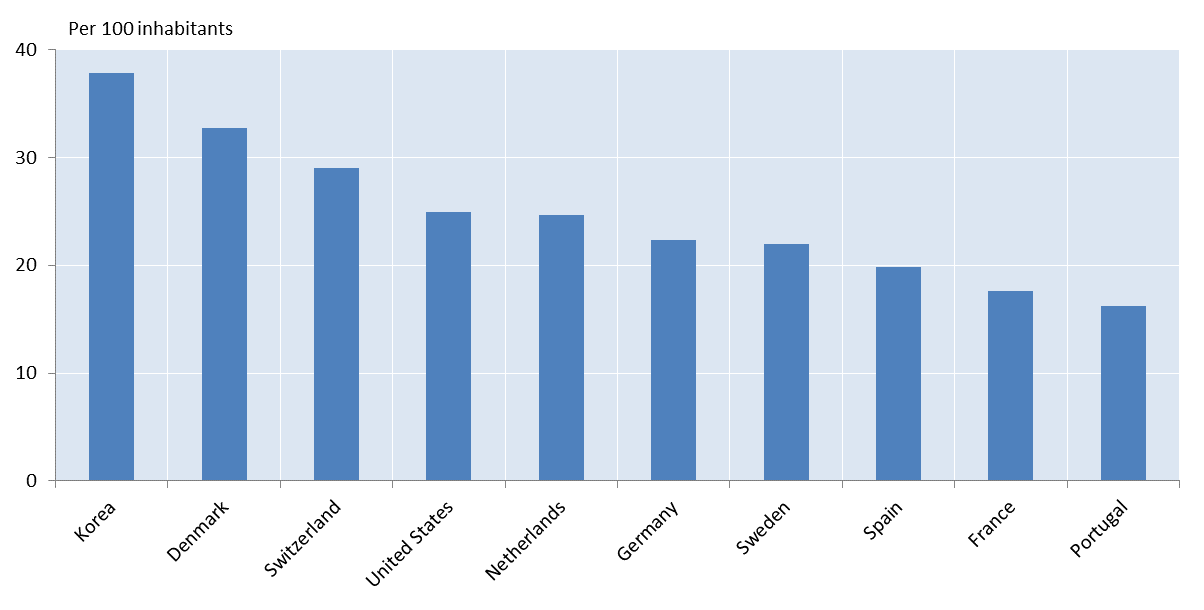Cathy Livingstone recognized at Annual Meeting
Cathy Livingstone, co-owner at Bryley Systems, was recognized at the Worcester County Food Bank (WCFB) Annual Meeting as a member of the Board of Directors at the WCFB.

Cathy Livingstone, co-owner at Bryley Systems, was recognized at the Worcester County Food Bank (WCFB) Annual Meeting as a member of the Board of Directors at the WCFB.

Intel released its Compute Stick; essentially, a low-end PC that can fit into the palm of your hand or mount onto a USB port on a monitor (as shown below where the Compute Stick is mounted at the top-left of the monitor). It sells for under $150.
Due to its small size and low-power use, it can be used in these (and other) areas:
It can be controlled remotely through a Bluetooth-enabled keyboard/mouse. There is also an Android-based application that enables control through your smartphone.
Highlights:
*Also available with Ubuntu 14.04 LTS.
We put it through its paces and found it slow, but adequate for low-end tasks. Its best feature is the small size, which can fit most anywhere.

With the introduction of Windows 10 this summer past, Microsoft (and its PC vendors like HP, Inc., Dell, Lenovo, etc.) are hoping for a significant surge in the sales of Windows-based desktops, notebooks, and tablets. However, the results to date have been modest at best.
Microsoft seems to have done a good job with Windows 10:
Windows is also somewhat of a player in mobile devices with increasing sales in Microsoft Surface (now a $1B business) and Lumina phones (purchased from Nokia), which contributes about $2B quarterly. (Although growing, these sales represent only 3% of the sales of mobile devices worldwide.) 4
These improvements seem to be part of Microsoft’s two-part mission:
On the positive side:
However, Windows is losing market share (and has been for some time) to other mobile devices like smartphones and tablets; there are over 2B people running Google Android or Apple iOS-based devices compared to about 1.5B running Microsoft Windows. 5
Another troubling trend: Although PC ownership is relatively stable among adults (at about 73%), PC ownership among 18 to 29 year olds dropped from 89% in 2012 to 78% in 2015. (This may change as these younger folk enter the workforce and require a full-sized keyboard and large or multiple monitors.) 6
Basically, Windows 10 is off to a good start, but only time will tell if the Windows franchise will retain its powerhouse status.
References
Winner of our CMBE raffle
We held a raffle at our booth at the Central Mass. Business Expo (CMBE) in Worcester on November 5th. Richard Tienhaara II (pictured below), from Aaron Industries Corp., won the prize; a Runtastic fitness-tracking bracelet.

With Windows 8 and Windows 10, Settings and Control Panel are separate entities with different functions; it would be nice to access both from the same folder when making configuration changes, rather than switching between the two.
GodMode is a simple and useful Windows shortcut: It combines Settings and Control Panel into one folder on your desktop.
To enable GodMode:
Please review Sarah Jacobson Purewal’s article Activate GodMode in Windows 10 in the August 18, 2015 edition of CNet.
Every day, someone’s computer cannot connect to something that they need to do their job; we call this downtime, usually caused by an outage, and it can impact a group of people within an organization, often at the least convenient of times.
CA Technologies surveyed 200 companies in 2011 and estimated that over $26.5 billion is lost each year in downtime; small organizations lost $55,000 (on average) each outage. (Please see InformationWeek’s: “IT Downtime Costs $26.5 Billion in Lost Revenue”.)
Not only that, outages tend to be lengthy (hours or days) and can damage an organization’s reputation. Plus, some industries (i.e.: manufacturing and financial services) can suffer a high rate of revenue loss.
Some components of downtime with significant value include:
Reduction in employee productivity
If you assume that employees are unable to do anything during a computer outage, it is not too hard to measure the cost: Number of employees impacted by the outage multiplied by the average cost/hour per employee. So, 100 employees making at an average of $40/hour (pay, benefits, and taxes) would be 100 employees * $40 average cost per hour = $4,000/hour.
However, most employees can find something productive to do during an outage:
Not exactly what their managers might want, but some productivity occurs during an outage, so you might want to add-in a productivity factor. For example: If you assume that employees are still 25% productive during an outage (meaning they are 75% unproductive), you can recalculate the cost per hour thus: 75% * 100 employees * $40 average cost per hour = $3,000/hour.
Revenue/opportunity loss
Revenue loss can sometimes be easy to quantify; a computer numerical control (CNC) machine tool waiting on the input of a computer-aided design (CAD) diagram or a computer-aided manufacturing (CAM) program can cost hundreds to thousands of dollars per hour in lost revenue if the CNC machine cannot access these items.
Opportunities lost are a bit tougher to quantify, but here are two examples:
Penalties assessed
Outages can put health at risk (i.e.: medical services) or can lead to missed deadlines (i.e.: overnight delivery); these situations can result in penalties assessed to your organization by a government agency or by the customer.
Bryley Systems introduces Joan Lunman, Internal Systems Advocate
Bryley Systems is pleased to announce that Joan Lunman has joined the company as Internal Systems Advocate. She has over 10-years of experience in the IT Service industry, having most recently worked at TAB Computer Systems Inc. in East Hartford, CT.
Joan has an excellent understanding of day-to-day operations as well as the functions of ConnectWise, the leading, IT-oriented, Professional Services Automation tool used at Bryley Systems and many other firms.
Joan has a BA from Potsdam State University in Potsdam, NY.

Monthly, we select a winner from all respondents to our service-ticket surveys. Congratulations to TG of TOB, our survey-response winner from last month.
Our winner received a $10 gift certificate, compliments of Bryley Systems.
Please join Bryley Systems as we host the Assabet Valley Chamber of Commerce (AVCC) November Coffee Connections, an early-riser networking opportunity.
The November Coffee Connections is on Friday, November 20th, from 7:30am to 9:00am in our office at 12 Main Street, Hudson, MA. There will be refreshments and door prizes while you network with over 50 professionals. Plus, you will have an opportunity to introduce yourself and your organization to all that attend.
The event is complimentary, but space is limited, so reservations are required. Free, two-hour parking is available on Main Street and on nearby side streets.
Please email Info@AssabetValleyChamber.org and ask to register for the November Coffee Connections at Bryley Systems.
Hope to see you then!

Pardon my skepticism, but it seems like IoT is just another catchy phrase to describe something that has been around for a while.
Coined in 1999 by Kevin Ashton, IoT refers to the connection of devices like house- hold appliances (washers, dishwashers), transport vehicles (automated carts and vehicles), sophisticated equipment (heart-monitoring implants), etc. to other devices or users through the Internet. Basically, these items operate autonomously, but can report on their status and can permit adjustment, intervention, and remote control while performing their programmed duties.
Wikipedia describes IoT as “…the network of physical objects or “things” embedded with electronics, software, sensors and network connectivity, which enables these objects to collect and exchange data… resulting in improved efficiency, accuracy, and economic benefit. Each thing is uniquely identifiable… but is able to interoperate within the existing Internet infrastructure.”
There are many older IoT-type applications already in use:
What exactly is new? Growth!
These early attempts were focused primarily on single applications for a limited audience; they basically feed unprocessed data forward or permitted single-user control. Current IoT efforts dream of utilizing big-data processing to unite information and disparate devices with a large population of users.
New and useful applications will arise and be connected, linking us to a brand new world. And, it will not be just embedded electronics in stationary devices, but also wearables (watches, health monitors, wireless cameras, etc.) and drive-ables (from vehicles with embedded computers to Google’s driverless cars) making up the IoT population.
The expectation is somewhere between 26 billion (Gartner says the Internet of Things will be 26 billion by 2020 by Gartner, Inc.) to 30 billion (More than 30 Billion devices will connect wirelessly to the Internet of Everything by ABI Research) IoT devices will be functional by 2020. Interestingly, the USA, at 24.9 online IoT devices per 100 inhabitants, currently lags behind South Korea (37.9), Denmark (32.7), and Switzerland (29.0) according to the OECD’s Digital Economy Outlook 2015, Chapter 6; Figure 6.6.

Issues
With tremendous growth comes great and, sometimes, undesired consequences. Issues being discussed and addressed include:
Data will explode, requiring greater storage, access, and processing
Where is all of this data going to be stored? Who will have access and how will it be enabled? What processing capabilities will be required to make sense of it all? After its useful life, how will data be removed (or at least archived)?
Internet bandwidth will be consumed and, at times, found lacking
Seems like bandwidth is already constrained in my home; will I need to unplug my refrigerator to watch Netflix? Will there be enough bandwidth not only inside the home or office, but also connecting the home/office to the Internet? Will Internet Service Providers be able to handle this coming surge in demand?
Wireless networks should expand and improve
Things don’t connect unless they are wired or have available wireless access: Will wireless networks be there when they are needed? Will they be able to provide sufficient bandwidth and coverage areas? Who will own them?
Security may be compromised
How will you safely authenticate devices against other devices and against multiple users? Can these devices be patched and/or updated in a secure and consistent manner? What if you purchase a smartHome and the previous owner does not release the smart technology; will you need to replace these items, or will there be a master override? (Marilyn Cohodas comments on some of these issues in her article: “4 IoT Cybersecurity Issues You Never Thought About” in the 9/24/2015 issue of InformationWeek DARKReading.)
Also, a July 2014 study by Hewlett-Packard found that six of 10 popular IoT devices surveyed were vulnerable to significant security issues and that seven of these devices used unencrypted network services. (See the article: “Popular Internet of Things devices are not Secure” by Lucian Constantin in the 7/30/2014 edition of ComputerWorld.)
Legal challenges shall multiply
What if your home-based device sent forth information you agreed to provide, but other family members of visiting friends did not wish to provide? Who is liable when this information ends up in the wrong hands?
Please review “Top 5 Legal Issues in the Internet of Things, Part 1: Data Security & Privacy” by Brian Wassom at Wassom.com.
Electricity use will change
Unless unplugged, electronics-enabled devices are connected 24×7, consuming electricity the entire time. Multiply this usage against billions of devices and our power needs and power consumption may change dramatically.
One promising note: Energy use will be monitored closely, with the likely result that optimization will occur, balancing power generation with energy use (and even decreasing energy use in some situations).
Privacy will be invaded
When my blender rats me out and tells the world that I made a chocolate shake after midnight, what will manufacturers conclude about me and my habits and who will they tell? Also, can I trust these manufacturers to use my household data wisely and keep it secure? Do standards exist to protect me from snooping?
See Brian Wassom’s article: “The Internet of Things that Eavesdrop and Invade Privacy” on 7/30/2015 at Wassom.com.
Evolving regulations and standards
Fortunately, the US Federal Government is addressing these areas with new insights and rulings:
Organizations and manufacturers are also upping the ante: IBM, Cisco, Microsoft, and many others are all weighing in with new technologies, products, and services.
The IoT is here now; it will get better with time, but make sure you know the risks and potential consequences when you enable it in your home or office.
Call our business managed IT services department directly at (978) 547-7221 or simply fill out this form and we will get in touch with you to set up a getting-to-know-you introductory phone call.




200 Union Street Clinton, MA 01510



© Copyright 2025 BRYLEY. All Rights Reserved. Website in partnership with Tech Pro Marketing. | Privacy Policy | Accessibility Statement
